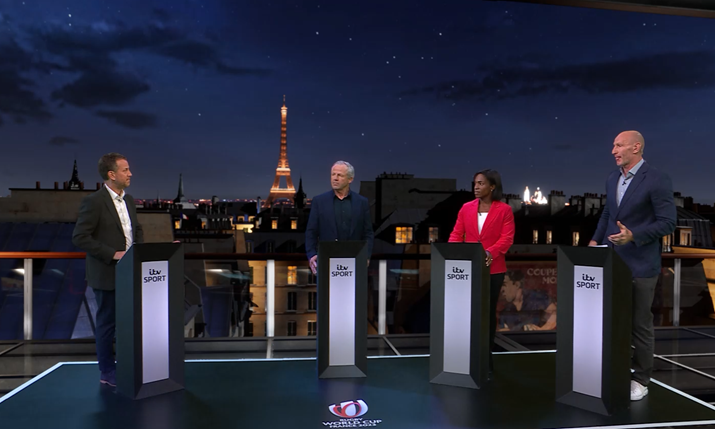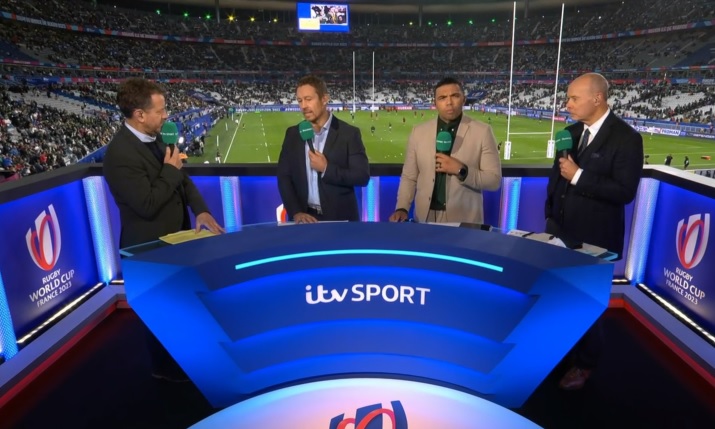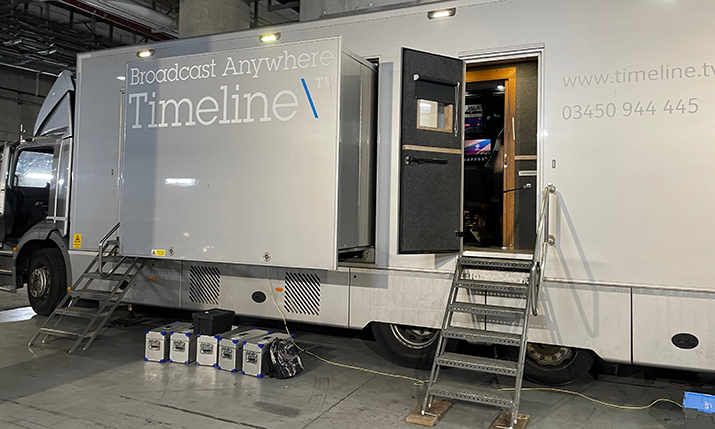Inside the production of ITV’s Rugby World Cup 2023 coverage
For ITV, the Rugby World Cup 2023 was a tournament of two halves. With the action taking place in nine cities across France from 8 September to 28 October, and with ITV committing to airing all 48 games live on ITV1, ITV4 and online service ITV X, the decision was made to use ITV’s interactive, mixed reality studio in the UK as the hub of its coverage of the group stages.
Paul McNamara, senior director and executive producer for major events at ITV, spoke with SVG Europe during the tournament. He explains: “With the games coming so thick and fast, the logistics of trying to move people around France for the group stages was really difficult, so it seemed like the obvious choice to have a base in the UK, which would also give us the choice of all our pundits and all presenters and help with sustainable production credibility.

“And then once we got to the quarter finals and beyond, because those games are only taking place in Marseille and Paris, it has been much easier to be fully on site in France.”
ITV introduced its new virtual studio set earlier this year, just in time for the Six Nations rugby tournament. McNamara explains how ITV approached the design of the virtual environment for the Rugby World Cup.
He says: “We had the traditional area that we’d used during the Six Nations reskinned for the World Cup, but I also wanted to give a bit of a view of Paris, so we went for the bold option of a balcony effect overlooking the city which I think has worked really well.”
The use of lecterns by presenters and pundits also had the twin effect of providing a physical grounding within the virtual environment for the on-screen talent and, because the presenters and pundits are stood at the lecterns, the camera angle allows for a better view of the Paris background.
“During the Rugby World Cup we’ve reached the nirvana of VR. If you look at the wide shots, you will see shadows created by VR engines…it’s subtle, but it looks much more real to the naked eye.”
ITV, together with MOOV, created backgrounds for different times of day and created different presentation spaces within the virtual studio. One such example is the demonstration area.
McNamara explains: “Rugby can be quite technical, and while we will always attract the mega rugby fans, there will also be millions who only come to this event because they are watching their particular country. While we don’t want to talk down to people who understand the intricacies of a scrum, we also don’t want to alienate people.”
Creative possibilities
After England fly-half George Ford kicked England to an unlikely victory against Argentina in the group stages, ITV was able to turn to pundit Jonny Wilkinson, one of the most successful rugby union kickers of all time, to explain the pressures and technique required to successfully kick drop goals.
“Having that ability within the studio, to be able to effectively flick a switch and move into a demonstration area, and then back to a dusky balcony environment provides the ultimate flexibility to be as creative as possible,” says McNamara.
ITV technical director Tony Cahalane explains how that flexibility has been extended to the use of galleries and green rooms in order to make maximum use of the green screen studio.
He says: “We have two galleries running so that when the match is on, one presentation team can leave the studio, and the next team can them come in and record sections for their upcoming game. We have effectively created two green room areas downstairs, both with facilities to talk to VT, to clip up things on EVS, communicate directly to the programme editors and to the both galleries.
“That means we can swap the talent teams during the live transmission, with a different team in the studio able to record bits for the next show. If there are any issues, then it literally takes 15-seconds to change the studio. We legislate for lost feed by having multiple routes into the building, but if we did lose any feeds then we can actually start voicing over a wide shot of a stadium for example while we physically move presenters back into position in the studio. So we’ve covered all avenues and got the maximum value out of the VR setup.”
Built in Unreal Engine, controlled using Brainstorm, and operated by MOOV, the five-camera studio set up is housed at Timeline TV’s Ealing Broadcast Centre in West London. AR graphics elements – from team line-ups to manager avatars – can be added too, also created by MOOV, with tracking via Mo-Sys Star Tracker.

England v South Africa: Pre-match discussion among presenter Mark Pougatch, plus pundits Jonny Wilkinson, Brian Habana and Clive Woodward
“During the Rugby World Cup we’ve reached the nirvana of VR,” says Cahalane. “If you look at the wide shots, you will see shadows created by VR engines. And that’s something which you won’t see anywhere else. It’s subtle, but it does make it look much more real to the naked eye.
“When we developed the VR Hub, we took the decision to heavily resource the vision mixer, with all sources delayed to match the VR engines and an ME bank of un-delayed sources.
“So, when we feed things into screens, there’s no bouncing around and having to double check things; it’s a really simple way of operating. It means for this event, we’ve got 72 inputs on the vision mixer, which is enormous. But that’s also to do with the fact that we bring back as much as we possibly can from site – the world feed, clean world feed, isolated camera feeds, and so on.”
ITV has four edit suites to support its output, plus what Cahalane describes as an “enormous” EVS operation for a show of this nature, with four 12-channel EVS XT Vias, plus another three devoted to media management. “For an event like this, there’s so much media coming in that needs to be pushed to our various platforms.”
ITV is one of seven broadcasters with a presence at the Rugby World Cup IBC, which is based at Roland Garros, in Paris. All of the host feeds are taken into the IBC and then routed to Ealing, along with diverse feeds that don’t go via the IBC to provide ITV with “two bites of the cherry should something go disastrously wrong,” says Cahalane.
Knockout coverage
On-site facilities are being provided by Timeline, which is covering off all aspects of the technical delivery. Throughout the tournament, Timeline has provided all outside broadcasts, remote production galleries, green screen studios, IBC MCR and connectivity and post-production.

Timeline on location at the Stade de France
For the knockout stages, ITV’s presentation team has moved from the Timeline-operated Ealing base to France, with coverage of matches anchored from presentation platforms within the stadium (pictured above), with four cameras on the platform, plus a pitch-side presentation position that has been used for all home nation matches throughout the tournament.
In addition, ITV has its own main camera on the gantry which has been put to good use of to tell the story from the ITV viewers’ perspective, providing an option for the programme editor or director if they want – or need – a specific shot.
McNamara explains: “During the opening ceremony President Macron delivered a speech, but it wasn’t subtitled, so all of a sudden, we were faced with five or six minutes solely in French on prime time ITV, which would have been a problem. Fortunately, with our own camera on the gantry, we were able to swing that towards the scoreboard in the stadium where the speech was being broadcast with subtitles, so we could put that to live. And there-in lies the advantage of always having your own unilateral presence, you can get out of jail, or you can tell the story that you need to tell.”
Read more
- Live from the Rugby World Cup 2023: World Rugby and HBS offer up additional content for rights-holding broadcasters
- Live from the Rugby World Cup 2023: Consistency and simplicity are key for host broadcast match coverage
- Live from the Rugby World Cup 2023: Referee mic plays crucial role in capturing atmosphere and ambience
- Live from the Rugby World Cup 2023: Digital content production offering proves popular with broadcasters and ‘TikTok Generation’ alike
- Live from Rugby World Cup 2023: Environmental sustainability underpins all World Rugby and HBS production efforts and decision-making

